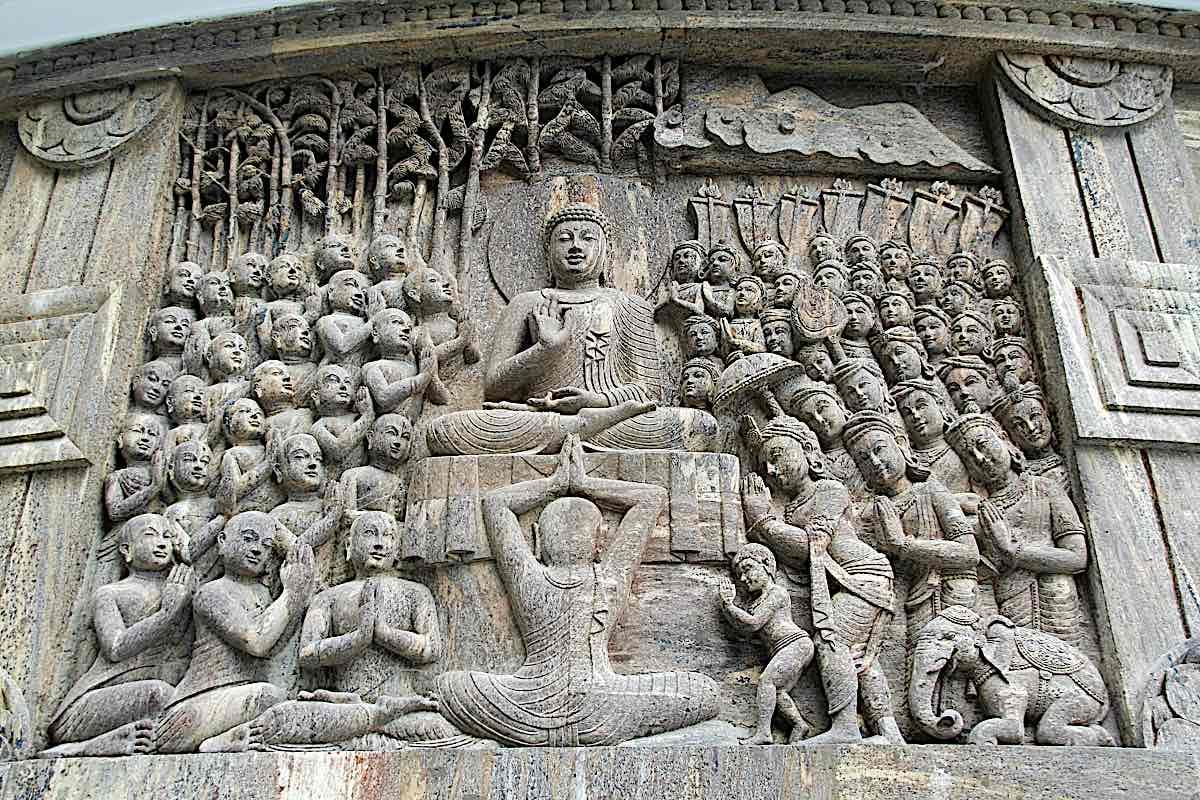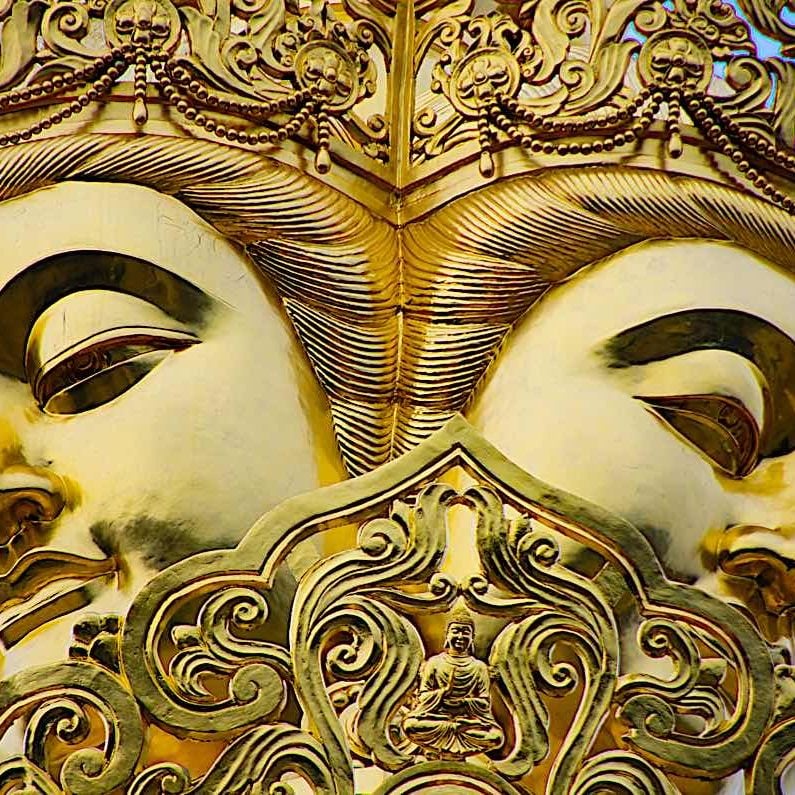Logic and Analysis: Buddha teaches in Magga-vibhanga Sutta — Analysis of the Noble Eightfold Path
The heart of Buddha’s teachings is the Eightfold Path — a prescription for our own personal path to realizations based on positive karmic conduct.
That does not stop the Buddha from analytical logic and debate. After the first teachings, Buddha spent decades teaching the path — a key method of teaching, as demonstrated in the Magga-vibhanga Sutta — and other sutras (suttas) — was analysis.

Clarity through analysis
Buddha taught with Questions and Answers. He taught with debate. He taught with deconstructive analysis.
The Buddha taught with logic, analysis, and discourse because he understood how we learn as human beings, and he wanted his teachings to be accessible to everyone.
The Buddha believed that through critical thought and careful deliberation, we can unlock the true potential of our minds and achieve enlightenment. Through the practice of analytical meditation — a process of deep contemplation in which we break down complex ideas into their constituent parts so that we can understand them more clearly — we can gain access to the insights for a breakthrough. We can obliterate the habits and actions that create obstacles on the path. In doing so, we can become more mindful and better equipped to navigate through our daily lives with wisdom, compassion, and clarity.

Don’t take the teachings on faith
Ultimately, Buddha’s teachings — as demonstrated in the Magga-vibhanga Sutta analyzing the Noble Eightfold Path — show us that through careful thought and critical analysis, we can uncover the deeper truths of existence and find lasting peace within ourselves.
Buddha didn’t ask us to believe everything he said. He asked us to think for ourselves. Buddha’s words of wisdom, engage in logical discourse and deconstructive analysis, and dedicate ourselves to the practice of analytical meditation so that we may ultimately achieve enlightenment.
The most often cited sutta focused on “proof” and analysis in Buddha’s teaching is the Kalama Sutta. In it, Buddha said:
“Do not go upon what has been acquired by repeated hearing; nor upon tradition; nor upon rumor; nor upon what is in a scripture; nor upon surmise; nor upon an axiom; nor upon specious reasoning; nor upon a bias towards a notion that has been pondered over; nor upon another’s seeming ability; nor upon the consideration, ‘The monk is our teacher.’ Rather, when you yourselves know that these things are good; these things are not blamable; undertaken and observed, these things lead to benefit and happiness, then and only then enter into and abide in them.”
Buddha is saying that we should not take anything on faith — even the Buddha’s own teachings. We should question everything and think for ourselves. Only when we have critically examined an idea and found it to be true, good, and helpful should we adopt it as our own.

Buddha’s advice is just as relevant today as 2500 years ago
Buddha’s call for questioning authority and thinking for ourselves is just as relevant today as it was 2,500 years ago. In a world where fake news, confirmation bias, and echo chambers are rampant, it is more important than ever that we learn to think for ourselves and engage in critical analysis. If we can do that, Buddha said, we will find true happiness and peace.
How does Buddha demonstrate this in his own teachings? Many of his teachings are in the form of debate. Others, as in the Magga-vibhanga Sutta (in full below), are in the form of logical analysis.
Either way, Buddha asks us to be logical, discerning, and intelligent. He didn’t ask for blind faith. He asked for meaningful dialogue, right conduct and an open mind to his teachings.
Magga-vibhanga Sutta — Analysis of the Noble Eightfold Path
I have heard that at one time the Blessed One was staying near Sāvatthī in Jeta’s Grove, Anāthapiṇḍika’s monastery. There he addressed the monks, “Monks!”
“Yes, lord,” the monks responded to him.
The Blessed One said, “I will teach & analyze for you the noble eightfold path. Listen & pay close attention. I will speak.”
“As you say, lord,” the monks responded to him.
The Blessed One said, “Now what, monks, is the noble eightfold path? Right view, right resolve, right speech, right action, right livelihood, right effort, right mindfulness, right concentration.
“And what, monks, is right view?
Knowledge with regard to [or: in terms of] stress, knowledge with regard to the origination of stress, knowledge with regard to the stopping of stress, knowledge with regard to the way of practice leading to the stopping of stress: This, monks, is called right view.
“And what, monks, is right resolve?
Resolve for renunciation, resolve for non-ill will, resolve for harmlessness: This, monks, is called right resolve.
“And what, monks, is right speech?
Abstaining from lying, abstaining from divisive speech, abstaining from harsh speech, abstaining from idle chatter: This, monks, is called right speech.
“And what, monks, is right action?
Abstaining from taking life, abstaining from stealing, abstaining from sexual intercourse: This, monks, is called right action.
“And what, monks, is right livelihood?
There is the case where a disciple of the noble ones, having abandoned dishonest livelihood, keeps his life going with right livelihood. This, monks, is called right livelihood.
“And what, monks, is right effort?
(i) There is the case where a monk generates desire, endeavors, activates persistence, upholds & exerts his intent for the sake of the non-arising of evil, unskillful qualities that have not yet arisen.
(ii) He generates desire, endeavors, activates persistence, upholds & exerts his intent for the sake of the abandoning of evil, unskillful qualities that have arisen.
(iii) He generates desire, endeavors, activates persistence, upholds & exerts his intent for the sake of the arising of skillful qualities that have not yet arisen.
(iv) He generates desire, endeavors, activates persistence, upholds & exerts his intent for the maintenance, non-confusion, increase, plenitude, development, & culmination of skillful qualities that have arisen. This, monks, is called right effort.
“And what, monks, is right mindfulness?
(i) There is the case where a monk remains focused on the body in & of itself—ardent, alert, & mindful—subduing greed & distress with reference to the world.
(ii) He remains focused on feelings in & of themselves—ardent, alert, & mindful—subduing greed & distress with reference to the world.
(iii) He remains focused on the mind in & of itself—ardent, alert, & mindful—subduing greed & distress with reference to the world.
(iv) He remains focused on mental qualities in & of themselves—ardent, alert, & mindful—subduing greed & distress with reference to the world. This, monks, is called right mindfulness.
“And what, monks, is right concentration?
(i) There is the case where a monk—quite secluded from sensuality, secluded from unskillful qualities—enters and remains in the first jhāna: rapture & pleasure born of seclusion, accompanied by directed thought & evaluation.
(ii) With the stilling of directed thoughts & evaluations, he enters & remains in the second jhāna: rapture & pleasure born of concentration, unification of awareness free from directed thought & evaluation—internal assurance.
(iii) With the fading of rapture, he remains equanimous, mindful, & alert, and senses pleasure with the body. He enters & remains in the third jhāna, of which the noble ones declare, ‘Equanimous & mindful, he has a pleasant abiding.’
(iv) With the abandoning of pleasure & pain—as with the earlier disappearance of elation & distress—he enters & remains in the fourth jhāna: purity of equanimity & mindfulness, neither pleasure nor pain. This, monks, is called right concentration.”
That is what the Blessed One said. Gratified, the monks delighted in the Blessed One’s words.
Video: Stumbling on the Buddha and the Eightfold Path. What would it have been like to stumble on the Buddha as he sat with his first five disciples to “Turn the Wheel of Truth” and the Noble Eightfold Path? Join our editor Lee Kane as imagines the scene — beautifully visualized with a sumptuous video visualization. Come with us now, to that serene scene in Deer Park, and meet the Buddha. Watch and listen in, as he shares his timeless wisdom.
“Magga-vibhanga Sutta: An Analysis of the Path” (SN 45.8), translated from the Pali by Thanissaro Bhikkhu. Access to Insight (BCBS Edition), 30 November 2013, http://www.accesstoinsight.org/tipitaka/sn/sn45/sn45.008.than.html .
More articles by this author

Samantabhadra’s The King of Prayers is the ultimate Buddhist practice how-to and itself a complete practice

The Five Strengths and Powers or pañcabalā in Buddhism — the qualities conducive to Enlightenment: faith, energy, mindfulness, concentration and wisdom

Tara’s Great Dharani Supreme of all Mantras –with Music version– and the Sutra of Tara Who Protects from the Eight Fears: in Tara’s Own Words
Search
Latest Features
Please support the "Spread the Dharma" mission as one of our heroic Dharma Supporting Members, or with a one-time donation.
Please Help Support the “Spread the Dharma” Mission!

Be a part of the noble mission as a supporting member or a patron, or a volunteer contributor of content.
The power of Dharma to help sentient beings, in part, lies in ensuring access to Buddha’s precious Dharma — the mission of Buddha Weekly. We can’t do it without you!
A non-profit association since 2007, Buddha Weekly published many feature articles, videos, and, podcasts. Please consider supporting the mission to preserve and “Spread the Dharma." Your support as either a patron or a supporting member helps defray the high costs of producing quality Dharma content. Thank you! Learn more here, or become one of our super karma heroes on Patreon.
Lee Kane
Author | Buddha Weekly
Lee Kane is the editor of Buddha Weekly, since 2007. His main focuses as a writer are mindfulness techniques, meditation, Dharma and Sutra commentaries, Buddhist practices, international perspectives and traditions, Vajrayana, Mahayana, Zen. He also covers various events.
Lee also contributes as a writer to various other online magazines and blogs.















